The Accumulator is a software program that reads the tape. Tape reading is a lost art. It was taught to me in 1979-1981 by Harold Lang who was 92 at the time. He had been trading for more than 60 years by the time I met him at EF Hutton in Boulder Colorado. Even today the stories he told me about the market and some of his experiences still ring true today so many years later. Despite all that has changed in the market, the truth of the tape has never changed. If you know what to look for and stick to your disciplines, reading the tape can give you insights into the character of trading between any two points in time.
There are 5 different Accumulators and each reads the tape differently. NO PRICE DATA IS USED. The Accumulator identifies buying and selling which often is different than what the price action shows. Not all up moves come from buying, not all down moves come from selling. HFT's can affect prices so quickly that what may appear to be a large move in price is actually an HFT taking out limit orders over a range of prices 'providing liquidity'. Many times it's only manipulation and the Accumulator used along side HFT Alert can help you identify what is really going on. This will not only help you avoid being faked out, but provide opportunities as well.
Not all Accumulators work for all stocks. You have to use them to figure out which Accumulator works for each symbol. Why? Because not all stocks trade the same hence not all Accumulators will be equally predictive. Accumulator 1 works best with GOOG and GLD, Accumulator 2 works especially well for US Steel (X), Accumulator 3 works really well for SPY. Accumulator 1 and 3 work well for most ETF's. But you have to work with each Accumulator for the particular issue you are monitoring and learn the type of patterns that become evident as the issue trades. As you become familiar with a particular issue, you will soon discover the behavior of the Accumulator that will identify trading opportunities.
Divergence and confirming the direction price is moving is what to look for when using the Accumulators:
- When price is falling and the Accumulator is rising, this is positive divergence; it's identifying that they're buying into the lows.
- When price is rising and the Accumulator is falling, this is negative divergence; it's identifying that they're selling into the highs.
- When price is rising and the Accumulator is rising, this is a normal pattern you'd expect to see.
- When Price is falling and the Accumulator is falling, this is the normal pattern you'd expect to see.
- When price is either falling or rising and the Accumulator is flat, it's telling you that the Accumulator you're watching is showing equal pressure on both sides.
One thing that is important to remember: Typically, only 1 of the 5 Accumulators will accurately predict price direction of the issue you are monitoring. By watching over time, you will be able to figure out which one to use.
The Accumulators run on a 1 minute time frame and accumulates data each second. It automatically archives the data it collects allowing longer term time frames to be charted. There are a variety of audio alarms for volume spike alerts as well as limit minders. The program includes trend lines, regressions, moving regressions and volume at price.
The formulas for and what the Accumulator actually measures is proprietary.
THE BASIC SIGNAL: The cyan colored line is the main Accumulator line and the purple line is the faster Accumulator. A signal is generated when the FAST (purple) crosses over the SLOW (cyan), and then the slow line changes slope in the new direction of the fast line shown as points A below. Often, there are 'tests' of the signal...these are shown as points B below. Trade for targets, do not wait to take a profit when the line changes slope; trade ranges. This particular chart is GOOG, using Accumulator #1.
The FAST line (purple) shows buying or selling. As it changes direction, the flow of buying or selling is indicated. If price is rising and this line begins to fall, then it is telling you that selling into the highs is occurring. When you see it move far from the SLOW (cyan) line, this is typically an exhaustion indication.
The gray horizontal bars at the left show relative volume at price over the number of data points currently on the chart. These are very helpful in identifying at what price the heaviest volume has accumulated, hence support and resistance levels. Where you see nulls, areas where there is very little volume, price will move through these areas very quickly.
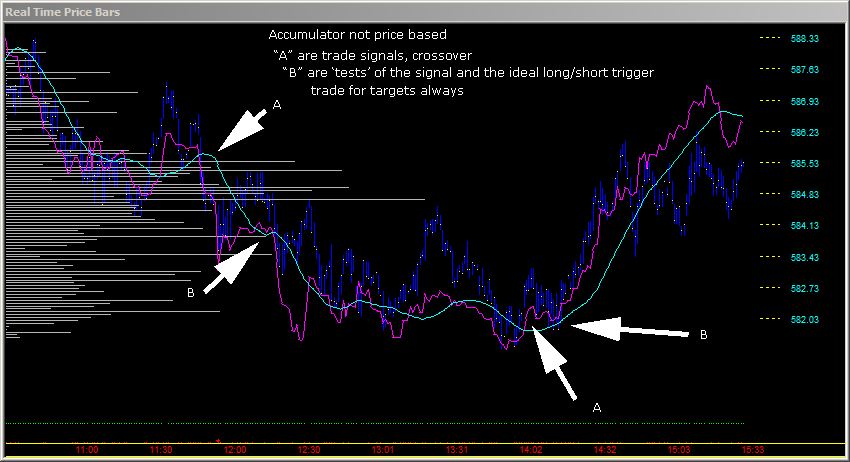
Accumulator #1: This Accumulator works best for GLD, GOOG and most illiquid stocks or those with moderate daily volume. Trading opportunities are identified as the Accumulator changes slope as described in the Basic Signal above. Here, the Accumulator was in a clear sell from the latter part of the prior day, point A. The slow (cyan) line flattens, point B, then the fast (purple) supports the rise in price from the lows indicating a long signal, point C. GOOG is shown here.
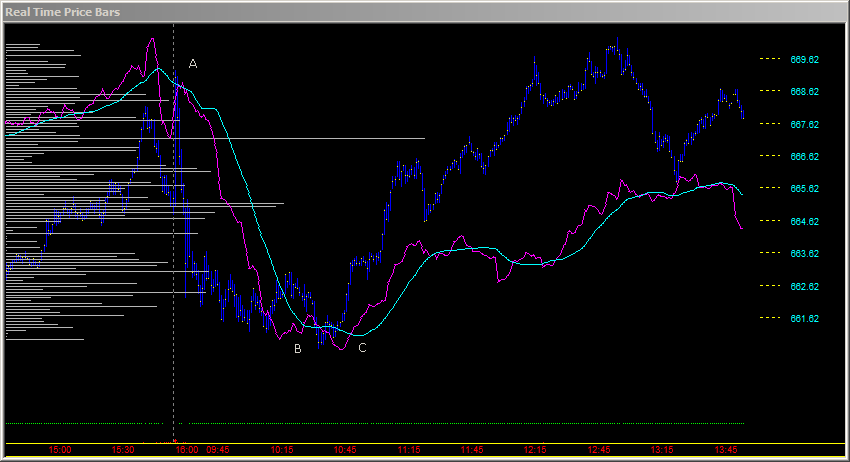
Accumulator #2: This Accumulator is the 'default' one to typically start watching on any security. It works well with X and many other issues. Trades are identified as the Accumulator changes slope as described in the Basic Signal above. Below we see X (US Steel) with the volume at price bars removed. Clear positive divergence is shown at the far left of the chart point A as price falls and the Accumulator rises. This told you to buy into the lows. A sell is shown at point B, exhaustion and a sell is shown at point C, positive divergence is again shown at point D telling you to buy into the lows. X is a great stock to trade and Accumulator #2 has worked well with it for years.
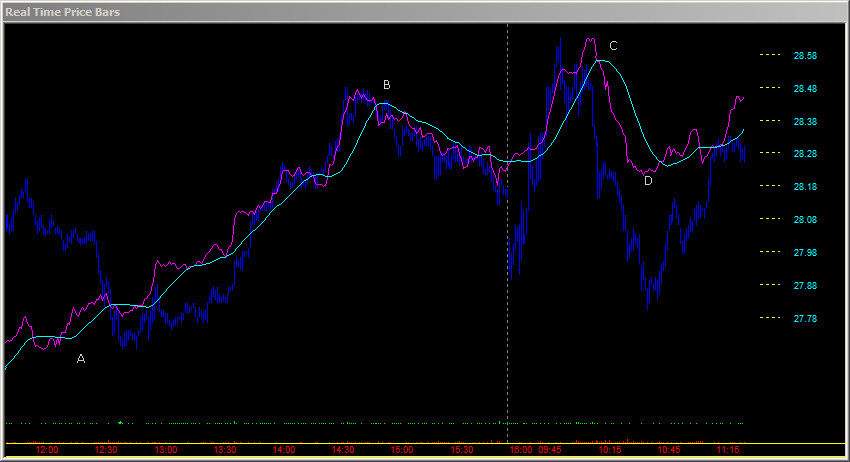
Accumulator #3: This Accumulator works especially well with SPY and shows divergences better than any other Accumulator for SPY. If you are trading SDS or SSO, run this Accumulator on SPY and make your trading decisions for SDS or SSO based upon what you are seeing on SPY. At point A we see the fast showing buying into the lows as price drops rather quickly from 127 to 126.50. At point B another reversal in the fast again showing strong buying into the 2nd low and a clear long signal as the fast moves back above the slow (cyan). Notice that the slow had already turned up at the first low. Price recovers to the initial break down level at 127 (a pattern that is very easy to trade). Positive divergence is shown at point C as price falls while the Accumulator continues to rise, price recovers again to the break down level at 127. A sell is shown at point D, and at E another long signal as the fast rises as price goes sideways for about 6 bars.
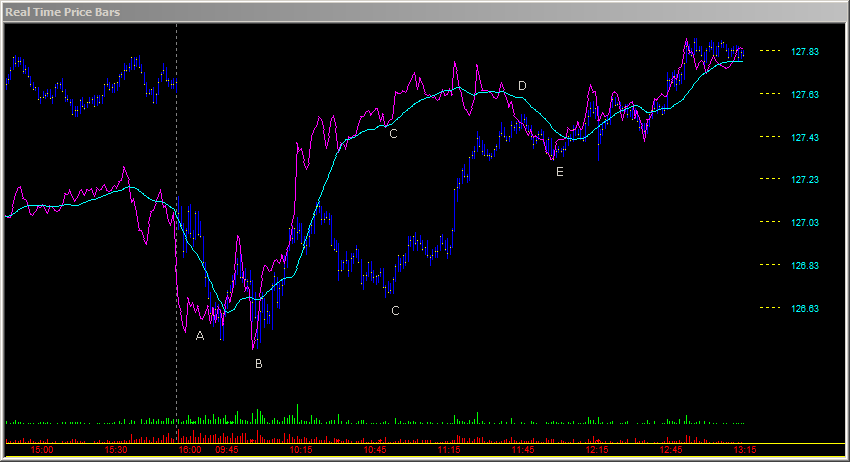
Accumulator #4: This Accumulator measures the Raw Tick. It nets up tick volume from down tick volume and shows this in the line. A rising raw tick line means that up tick volume exceeds down tick volume and visa versa. This Accumulator is not very predictive. But it is very useful in examining the actual tick and can be used to more closely examine certain points in time. Below we SPY for the same period as in the Accumulator #3 image directly above. You can see how different the two charts are. You really need to watch the fast on the raw more so than the slow. At point A for example, we can see that up tick volume turned up before the low was made. This supports point A in the chart above.
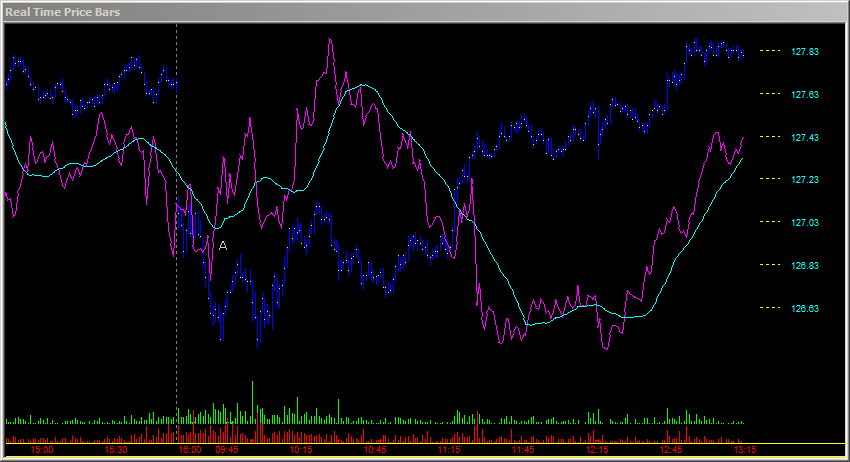
Accumulator #5: This Accumulator is a combination of Accumulators #1 and #2. It is useful for very illiquid stocks that have sparse periods of time during the day where few trades occur. Below we see NVEC over a 6 days. There are very few trades each day and this Accumulator can be helpful in tracking such stocks.
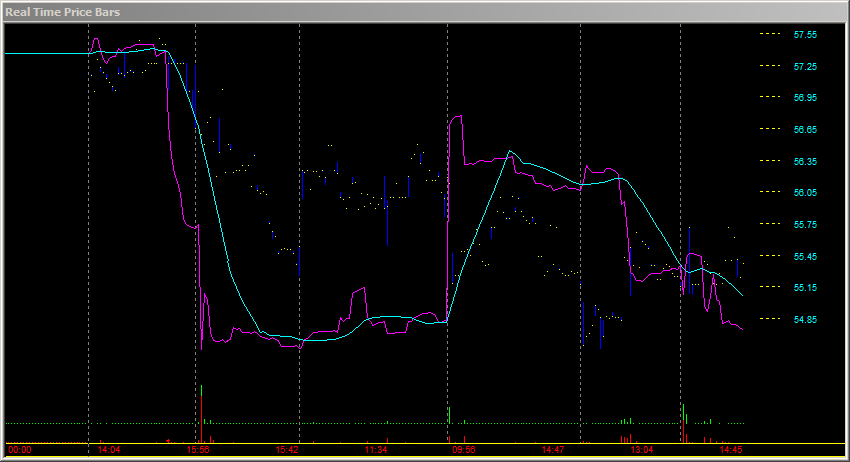
click image below to view video (flash)
This video demonstrates using HFT Alert alongside the Accumulator on SPY. It shows a period of time when HFT and Algo programs had manipulated prices higher while the Accumulator identified negative divergence. This enabled you to build short positions into a price rise that HFT Alert and the Accumulator identified as being false. This type of activity occurs frequently during the week both on the upside and downside. Only HFT Alert and the Accumulator run together can give you this level of insight into trading.
